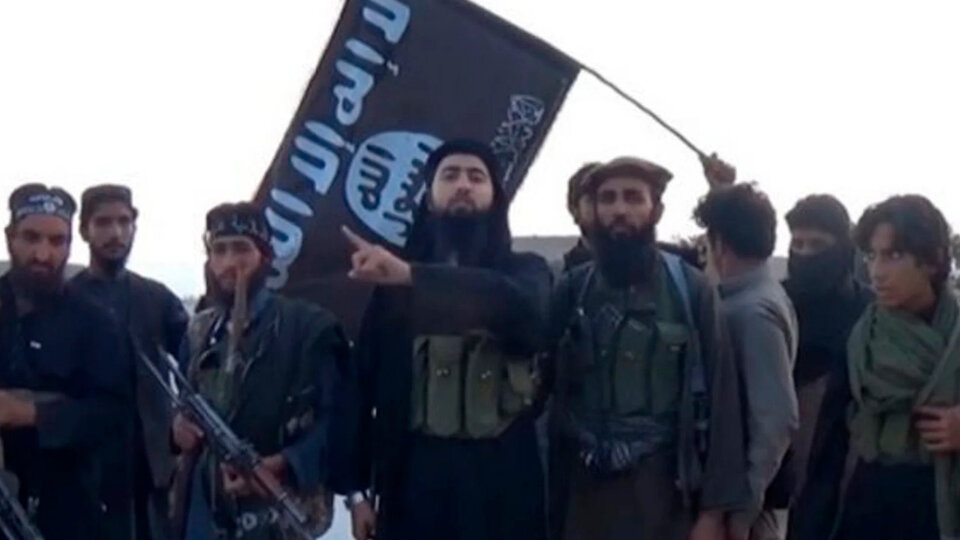
[ad_1]
The Taliban, who have taken over power in Afghanistan, have a long-standing confrontation with the jihadist Islamic State (ISIS), a group the Pentagon sees as a threat to the thousands of Afghans desperate to flee Kabul. This Thursday two explosions left at least 15 dead and dozens injured at the gates of the airport of the Afghan capital. There was hardly the double attack, the suspicions of the American intelligence sectors were aimed at the regional branch of the Islamic State, the Islamic State-Khorasan group (Isis-K). The president himself, Joe biden, had anticipated a few days ago a “Acute and increasing risk” of attack in the zone.
What is the Islamic State-Khorasan?
Months after ISIS declared a caliphate in Iraq and Syria in 2014, a group of former Pakistani Taliban pledged allegiance to it and joined other militants in Afghanistan. to form a regional section. ISIS’s central leadership officially recognized the group a year after it settled in northeastern Afghanistan, in Kunar, Nangarhar and Nuristan provinces. The group has also established cells in other parts of Pakistan and Afghanistan, including Kabul, according to UN monitoring.
At its peak, in 2016, it is estimated that there were between 2,500 and 8,500 combatants, But the continuation of the Afghan army’s counterterrorism operations with air support and American special forces lowered that number at the end of 2019 to between 2,000 and 4,000. The latest estimates of their strength range from thousands of active fighters to 500, according to a UN Security Council report released in July.
“Khorasan” is a historic name for the region which includes parts of what is now Pakistan, Iran, Afghanistan and Central Asia., which gives the faction the name ISIS-K. To believe, In short, that the Taliban are not sufficiently devoted to Islam and for this reason they have maintained hostilities even before the return of the Taliban to power.
What types of attacks do they carry out?
ISIS-K has claimed responsibility for some of the wildest attacks in recent years in Afghanistan and Pakistan. He slaughtered civilians in both countries in mosques, shrines, squares and hospitals.
The Sunni extremist group has particularly targeted Muslims it considers to be heretics, in particular the Shiites. In August 2019, he claimed responsibility for the attack on the Shiites at a wedding in Kabul, in which 91 people died.
In addition, he is suspected of an attack that shook the world in May 2020 in Kabul. Gunmen opened fire on maternity hospital in predominantly Shiite neighborhood, killing 25 people, including 16 mothers and newborns.
What is Isis-K’s relationship with the Taliban?
Although the two groups are extremist Sunni Islamic militants, they are also rivals and differ in areas such as religion and strategy. Each claims to be the true banner of jihad. In a demonstration of their enmity, ISIS statements label the Taliban as apostates.
ISIS-K faced Taliban crackdown on dissidents and failed to expand territory, just as he succeeded in doing in Iraq and Syria. In 2019, the Afghan government army, after joint operations with the United States, announced that it had defeated it in Nangarhar province.
According to US and UN intelligence assessments, ISIS-K has since operated largely through sleeper cells in cities to carry out attacks with some media coverage.
How did ISIS receive the Taliban victory?
ISIS has strongly criticized last year’s deal between Washington and the Taliban. which resulted in a pact to withdraw foreign troops, accusing them of abandoning the jihadist cause. After the rapid takeover of Afghanistan by the Taliban, various jihadist groups around the world hailed his return, but not Isis.
An ISIS document released after the fall of Kabul accuses the Taliban of betraying the jihadists with the deal with Washington and promises to continue their fight, according to the SITE Intelligence Group, which monitors communications from militant groups.
What is the threat at Kabul airport?
Government officials from the United States and other Western countries had warned that Kabul airport, with thousands of American troops surrounded by huge crowds of Afghans desperate to emigrate, was threatened by force from insurgents.
In recent days, military transport planes have left the Afghan capital by firing decoys, especially those intended to deflect missiles. The area is also potentially exposed to mortar fire and suicide bombings, experts say.
Several analysts, including ExTrac, a private group specializing in the processing of data from jihadist groups, point out that Isis-K abruptly stopped its activity 12 days ago. Islamic State affiliates often disappear from the map when they activate ‘survival mode’ or when planning a major attackExTrac explained.
.
[ad_2]
Source link
 Naaju Breaking News, Live Updates, Latest Headlines, Viral News, Top Stories, Trending Topics, Videos
Naaju Breaking News, Live Updates, Latest Headlines, Viral News, Top Stories, Trending Topics, Videos